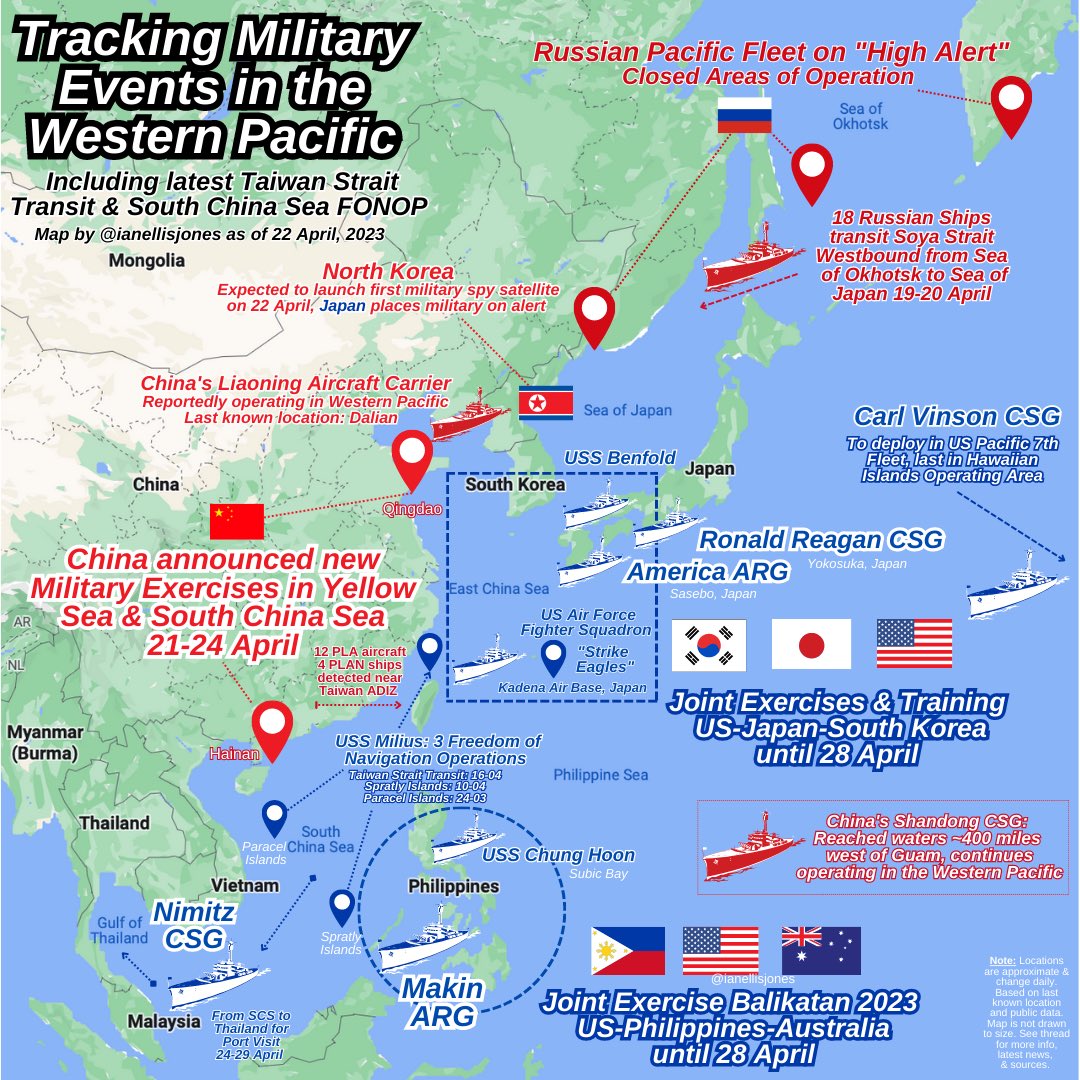🚨Major military activity continues in the Pacific.
Updated map & new developments:
- China: 2 new military exercises underway
- First time 2 Chinese aircraft carriers operate simultaneously
- Carl Vinson Carrier Strike Group enters Pacific
- 18 Russian ships pass near Japan
Updated map & new developments:
- China: 2 new military exercises underway
- First time 2 Chinese aircraft carriers operate simultaneously
- Carl Vinson Carrier Strike Group enters Pacific
- 18 Russian ships pass near Japan

Militaries from the US, Taiwan, Japan, South Korea, Philippines, Australia, China, Russia, & North Korea are exercising & operating in the Western Pacific this weekend.
This is not being reported by the media.
I researched for hours so you can get up to speed in minutes.
This is not being reported by the media.
I researched for hours so you can get up to speed in minutes.
https://twitter.com/ianellisjones/status/1648186608552751104
1. China announced 2 new military exercises near Qingdao in the Yellow Sea & Hainan in the South China Sea.
This is in addition to the "major military activity" that took place on Tuesday.
The drills are underway, ongoing for over 24 hours, & expected to end on 23-24 April.
This is in addition to the "major military activity" that took place on Tuesday.
The drills are underway, ongoing for over 24 hours, & expected to end on 23-24 April.
https://twitter.com/ianellisjones/status/1649590837829857287
2. Chinese media is reporting that the Liaoning aircraft carrier is operating in the Western Pacific, in addition to the Shandong CSG.
*If* this reporting is true, it would be the first time 2 Chinese aircraft carriers were operating in the Pacific together at the same time.
*If* this reporting is true, it would be the first time 2 Chinese aircraft carriers were operating in the Pacific together at the same time.

3. Carl Vinson CSG completed training in the Hawaiian Islands operating area "in preparation for an upcoming deployment."
The ships & aircraft of the CSG, led by its flagship, USS Carl Vinson (CVN 70), are made up of more than 5,000 Sailors & will deploy in Pacific @US7thFleet.
The ships & aircraft of the CSG, led by its flagship, USS Carl Vinson (CVN 70), are made up of more than 5,000 Sailors & will deploy in Pacific @US7thFleet.
https://twitter.com/ianellisjones/status/1649810149056413696
4. Japan's Ministry of Defense issued a press release stating that 18 Russian ships transited the Soya Strait & entered the Sea of Japan on 19-20 April.
https://twitter.com/ryankakiuchan/status/1649375783285297152
5. The US Embassy in Thailand released a statement that the Nimitz CSG will visit Thailand from 24-29 April.
Over the past ~2 weeks, the Nimitz CSG transited from South Korea to the Eastern Coast of Taiwan, operating in the Philippine Sea before moving to the South China Sea.
Over the past ~2 weeks, the Nimitz CSG transited from South Korea to the Eastern Coast of Taiwan, operating in the Philippine Sea before moving to the South China Sea.

6. US Air Force advanced aircraft arrived at Kadena Air Base, Japan, on 22 April.
Kadena is a USAF base located ~650km off the coast of China and is often referred to as the "Keystone of the Pacific" because of its highly strategic location.
Kadena is a USAF base located ~650km off the coast of China and is often referred to as the "Keystone of the Pacific" because of its highly strategic location.
https://twitter.com/usairforce/status/1648109902382899208
7. Japan puts military on alert fearing North Korean missile launch on Saturday.
"Japan ordered its military on Saturday to prepare to shoot down a North Korean ballistic missile after Pyongyang said this week it was ready to launch its first military spy satellite."
"Japan ordered its military on Saturday to prepare to shoot down a North Korean ballistic missile after Pyongyang said this week it was ready to launch its first military spy satellite."

8. Planned combined military exercises & ongoing operations continue until 28 April between:
- The US, Japan, South Korea, & Taiwan in the East China Sea, Philippine Sea, & Sea of Japan.
- The US, Philippines, & Australia in the Philippine Sea & South China Sea for #Balikatan23
- The US, Japan, South Korea, & Taiwan in the East China Sea, Philippine Sea, & Sea of Japan.
- The US, Philippines, & Australia in the Philippine Sea & South China Sea for #Balikatan23
https://twitter.com/ianellisjones/status/1644414634726760459
9. Tracking other US Naval Assets in the region:
- Ronald Reagan CSG forward-deployed in Yokosuka, Japan
- America Amphibious Ready Group (ARG) in Sasebo, Japan
- Makin Island ARG underway in the Philippine Sea
- USS Chung Hoon departed Subic Bay, Philippines
- Ronald Reagan CSG forward-deployed in Yokosuka, Japan
- America Amphibious Ready Group (ARG) in Sasebo, Japan
- Makin Island ARG underway in the Philippine Sea
- USS Chung Hoon departed Subic Bay, Philippines
https://twitter.com/ianellisjones/status/1648117668010942464
• • •
Missing some Tweet in this thread? You can try to
force a refresh














